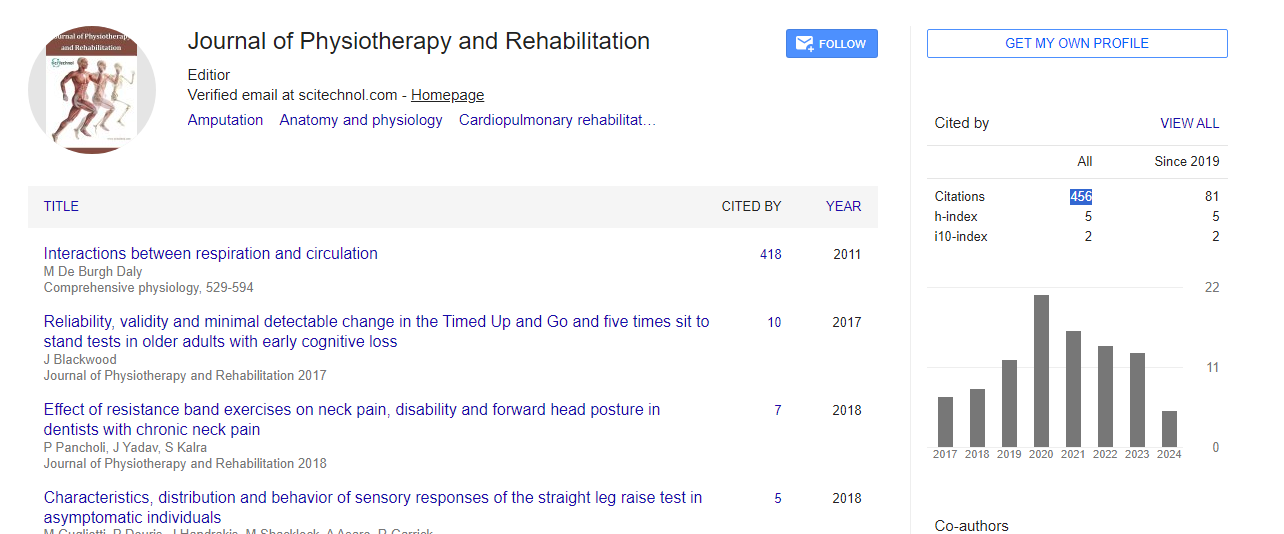Perspective, J Physiother Rehabi Vol: 8 Issue: 5
Combining Artificial Intelligence and Robotics to Personalize Rehabilitation for Patients with Neuromuscular Disorders
Emma Hawthorne*
1Department of Rehabilitation, Mater Misericordiae University Hospitals, Dublin, Ireland
*Corresponding Author: Emma Hawthorne,
Department of Rehabilitation, Mater
Misericordiae University Hospitals, Dublin, Ireland
E-mail: haethorneem@10520.ir
Received date: 24 September, 2024, Manuscript No. JPTR-24-151639
Editor assigned date: 26 September, 2024, PreQC No. JPTR-24-151639 (PQ);
Reviewed date: 10 October, 2024, QC No. JPTR-24-151639
Revised date: 17 October, 2024, Manuscript No. JPTR-24-151639 (R);
<br />Published date: 24 October, 2024, DOI: 10.4172/JPTR.1000183.
Citation: Hawthorne E (2024) Combining Artificial Intelligence and Robotics to Personalize Rehabilitation for Patients with Neuromuscular Disorders. J Physiother Rehabi 8:5.
Description
The integration of Artificial Intelligence (AI) and robotics in rehabilitation is transforming the way therapies are customizing for patients with neuromuscular disorders. Neuromuscular disorders, which impair the communication between the nervous system and muscles, can severely affect movement, coordination and overall physical function. Traditional rehabilitation methods often involve repetitive, generalized exercises, which may not fully address the specific needs of individual patients. However, by combining AI and robotics, personalized rehabilitation programs can be designed to optimize recovery and improve patient outcomes.
AI plays an important role in analyzing more amounts of data generated during rehabilitation sessions. This data includes information about a patient’s movements, muscle activity and progress over time. Machine learning algorithms process this data to identify patterns, adapt exercises and provide real-time feedback to both patients and clinicians. As a result, rehabilitation programs become more dynamic, adjusting in response to the patient’s current abilities and progress. This level of personalization is difficult to achieve with traditional methods, which often depends on standardized exercises that may not consider individual differences in recovery rates or motor function.
Robotic devices are essential in delivering these personalized rehabilitation programs. They provide precise, consistent and measurable assistance in performing movements that patients might otherwise struggle to achieve. For instance, robotic exoskeletons can assist patients in walking or moving their arms, depending on the area of impairment. These devices are equipped with sensors that monitor the patient’s movements and physical responses in real time. Through the integration of AI, the robot can adjust the level of assistance based on the patient’s needs, ensuring that the exercise remains challenging yet achievable. This adaptability helps in gradually improving the patient’s strength and mobility. One of the key advantages of using AI and robotics in rehabilitation is the ability to tailor therapy to each patient’s unique condition. Patients with neuromuscular disorders vary greatly in terms of the severity of their impairment and the rate at which they recover. AI-driven systems can analyze individual patient data to predict the best course of action for their rehabilitation. For example, if a patient demonstrates a particular difficulty with certain movements, the system can modify the exercise to focus on that area while reducing strain on unaffected parts of the body. This allows for a more efficient and effective rehabilitation process, as the exercises are customized to target the patient’s specific challenges.
Another benefit of this technology is its ability to provide continuous monitoring and feedback. Traditional rehabilitation often requires frequent visits to a clinic or therapist, limiting the amount of real-time guidance a patient can receive. With AI and robotic systems, patients can receive feedback during every session, regardless of whether they are in a clinic or at home. This feedback helps patients correct their movements and improve their performance in real time, leading to faster progress. Additionally, the system can track long-term progress and make data-driven adjustments to the rehabilitation program as needed.
Conclusion
The combination of AI and robotics is revolutionizing rehabilitation for patients with neuromuscular disorders. By personalizing therapy programs, providing real-time feedback and continuously adapting to the patient’s needs, this technology enhances the effectiveness of rehabilitation and accelerates recovery. As AI and robotic systems continue to advance, they will likely become integral components of rehabilitation programs, offering patients a more customize and responsive approach to restoring their physical function and independence.
 Spanish
Spanish  Chinese
Chinese  Russian
Russian  German
German  French
French  Japanese
Japanese  Portuguese
Portuguese  Hindi
Hindi 